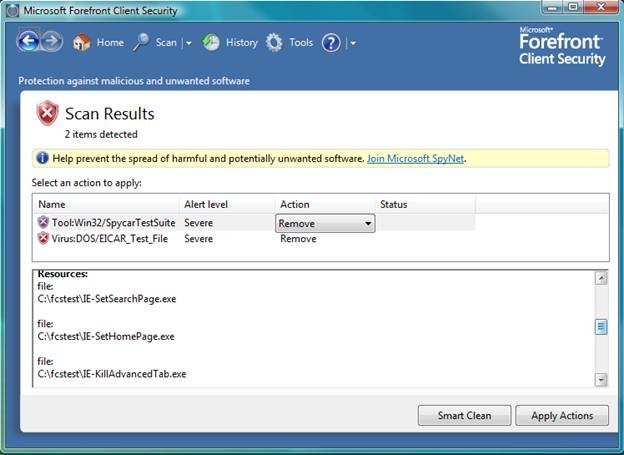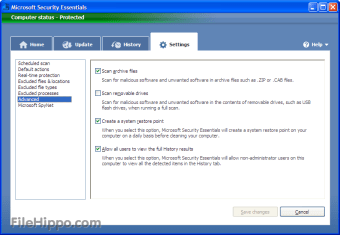In the time since the System Center 2012 release, though, the Forefront Endpoint Security line has largely been discontinued, with Microsoft focusing more on adding anti-malware and enhanced security protection into individual products such as Windows Server 2012, Exchange Server 2013, SharePoint. Hello, What is the Recovery Model requirement with SQL Server 2005 for Forefront Client Security? Thanks, Dom System Center Operations Manager 2007 / System Center.
My old laptop contains two security programs: Avast (free download) and Microsoft Forefront Client Security (It just appeared one day, don't know where it came from). The MSFCS really burdens my processor slowing the computer down quite a bit. Microsoft Forefront is a discontinued family of line-of-business security software by Microsoft Corporation.Microsoft Forefront products are designed to help protect computer networks, network servers (such as Microsoft Exchange Server and Microsoft SharePoint Server) and individual devices. As of 2015, the only actively developed Forefront product is Forefront Identity Manager. Microsoft Security Essentials & ForeFront Client Security Definition Updates is a complete update package that will help your computer function properly by assisting the antivirus to do the desired tasks. The package includes information for both Microsoft Security Essentials and Microsoft ForeFront Client Security.
Forefront Client Security is a unified Internet security software package from Microsoft. Forefront Client Security provides business networks with protection from viruses, worms and other malware threats. The software can protect all of the machines on a Windows network infrastructure, including the servers and the client desktops and laptops.
Functions
Forefront Client Security provides real-time protection from viruses and other threats and offers a range of scans for malware. The software can also scan for any potential security issues on each machine, including the use of blank passwords.
Management
Forefront Client Security, in common with other business-focused Internet security products, includes features to assist network administrators in centrally managing their Internet security provision.
Through integration with Microsoft's Active Directory and Software Update Services, you can use the software's deployment features to roll out the software to computers on the network without needing to visit each PC individually. Malware updates download centrally to one or more servers for deployment to the client computers.
Architecture
Forefront Client Security is a scalable solution, capable of deployment across very large computer networks. Depending on your network size, you can choose from a range of suggested installation topologies when installing the product. Networks of up to 3,000 computers can use a single physical server for Forefront Client Security, which can manage all functions of the software. Larger networks can use up to six individual servers, with the software's various functions, including reporting and update distribution, split across the individual servers.
Compatibility
Microsoft developed Forefront Client Security for servers and computers running the its Windows operating system. The software is compatible with servers running Windows 2000 Server or later and client computers running Windows XP or later.
Replacement
As at February 2011, Microsoft has replaced Forefront Client Security with a newer product. Forefront Endpoint Protection 2010 has superseded the older software. As at February 2011, technical support and malware updates are still available for Forefront Client Security.
References
About the Author
Benny Taylor has been writing travel, food and computer articles since 2009. His articles about Portugal have been featured by “Living Abroad” magazine. Taylor studied ITIL IT service management in the City of London and is also a Microsoft-certified small-business specialist.
Photo Credits
- Thinkstock Images/Comstock/Getty Images
More Articles
Vulnerability in Microsoft Forefront Protection for Exchange Could Allow Remote Code Execution (2927022)
Published: February 11, 2014
Version: 1.0
General Information
Executive Summary
This security update resolves a privately reported vulnerability in Microsoft Forefront. The vulnerability could allow remote code execution if a specially crafted email message is scanned.
This security update is rated Critical for all supported builds of Microsoft Forefront Protection for Exchange 2010. For more information, see the subsection, Affected and Non-Affected Software, in this section.
The security update addresses the vulnerability by removing the vulnerable code from Microsoft Forefront Protection for Exchange Server. For more information about the vulnerability, see the Frequently Asked Questions (FAQ) subsection for the specific vulnerability entry under the next section, Vulnerability Information.
Recommendation. Microsoft recommends that customers apply the update immediately.
See also the section, Detection and Deployment Tools and Guidance, later in this bulletin.
Knowledge Base Article
- Knowledge Base Article: 2927022
- File Information: Yes
- SHA1/SHA2 hashes: Yes
- Known issues: None
Affected and Non-Affected Software
The following software has been tested to determine which versions or editions are affected. Other versions or editions are either past their support life cycle or are not affected. To determine the support life cycle for your software version or edition, see Microsoft Support Lifecycle.
Affected Software
| Software | Maximum Security Impact | Aggregate Severity Rating | Updates Replaced |
| Microsoft Forefront Protection 2010 for Exchange Server[1][2] (2927022) | Remote Code Execution | Critical | None |
Microsoft Forefront Client Security Updates
The update only applies to systems running Microsoft Forefront Protection 2010 for Exchange Server version 11.0.727.0. For more information, see the **UpdateFAQ**. **Non-Affected Software**| Software |
| Exchange Online Protection |
| Microsoft Forefront Server Security Management Console |
| Microsoft Forefront Protection 2010 for SharePoint |
| Microsoft Forefront Security for Exchange Server Service Pack 2 |
| Microsoft Forefront Security for Office Communications Server |
| Microsoft Forefront Threat Management Gateway 2010 |
| Microsoft Forefront Client Security |
| Microsoft Forefront Endpoint Protection 2010 |
| Microsoft Forefront Security for SharePoint Service Pack 3 |
| **Vulnerability Severity Rating and Maximum Security Impact by Affected Software** | ||
| **Affected Software** | **RCE Vulnerability - CVE-2014-0294** | **Aggregate Severity Rating** |
| Microsoft Forefront Protection 2010 for Exchange Server | **Critical** Remote Code Execution | **Critical** |
RCE Vulnerability – CVE-2014-0294
A remote code execution vulnerability exists in Forefront Protection for Exchange. An attacker who successfully exploited this vulnerability could run arbitrary code in the security context of the configured service account.
To view this vulnerability as a standard entry in the Common Vulnerabilities and Exposures list, see CVE-2014-0294.
Mitigating Factors
Microsoft has not identified any mitigating factors for this vulnerability.
Workarounds

Microsoft has not identified any workarounds for this vulnerability.
FAQ
What is the scope of the vulnerability?
This is a remote code execution vulnerability.
What causes the vulnerability?
When mail content is not properly parsed, conditions exist where an attacker could run arbitrary code in the security context of the configured service account when a specially crafted email message is scanned.
What might an attacker use the vulnerability to do?
An attacker who successfully exploited this vulnerability could run arbitrary code in the security context of the configured service account on the target system running Forefront Protection 2010 for Exchange Server.
How could an attacker exploit the vulnerability?
An unauthenticated attacker could attempt to exploit this vulnerability by sending a specially crafted email message to an Exchange server that is monitored by affected versions of Forefront Protection 2010 for Exchange.
Microsoft Forefront Client Security Update
What systems are primarily at risk from the vulnerability?
Systems that are running an affected version of Forefront Protection 2010 for Exchange server are primarily at risk.
What does the update do?
The security update addresses the vulnerability by removing the vulnerable code from Forefront Protection 2010 for Exchange Server.
When this security bulletin was issued, had this vulnerability been publicly disclosed?
No. Microsoft received information about this vulnerability through coordinated vulnerability disclosure.
When this security bulletin was issued, had Microsoft received any reports that this vulnerability was being exploited?
No. Microsoft had not received any information to indicate that this vulnerability had been publicly used to attack customers when this security bulletin was originally issued.

Detection and Deployment Tools and Guidance
Manage the software and security updates you need to deploy to the servers, desktop, and mobile systems in your organization. For more information see the TechNet Update Management Center. The Microsoft TechNet Security website provides additional information about security in Microsoft products.

Security updates are available from the Microsoft Download Center. You can find them most easily by doing a keyword search for 'security update.'
Security Update Deployment
Forefront Protection 2010 for Exchange Server
Reference Table
The following table contains the security update information for this software.
| Security update file names | For all supported editions of Forefront Protection 2010 for Exchange Server: ForefrontProtectionforExchange-KB2927022-x86.exe |
| Restart requirement | This update does not require a restart, unless the affected files are being used. If the affected files are in use and an update is required, a message will appear advising you that a restart is required. To help reduce the chance that a restart will be required, stop all affected services and close all applications that may use the affected files prior to installing the security update. For more information about the reasons why you may be prompted to restart, see Microsoft Knowledge Base Article 887012. |
| Removal information | To uninstall, click Control Panel, click Programs, click Programs and Features, under Installed Updates, right-click 'Security Update for Microsoft Forefront Server Protection (KB2927022),' then click uninstall. |
| File information | See Microsoft Knowledge Base Article 2927022 |
| Registry key verification | Note A registry key does not exist to validate the presence of this update. |